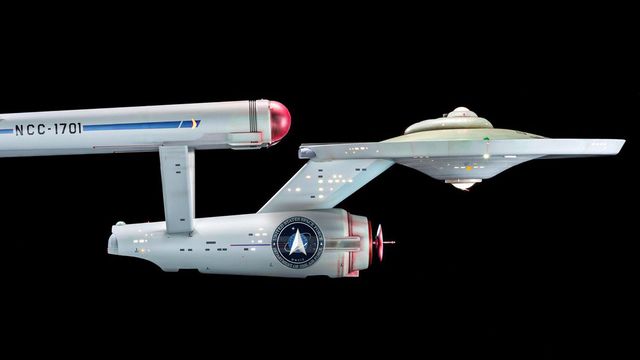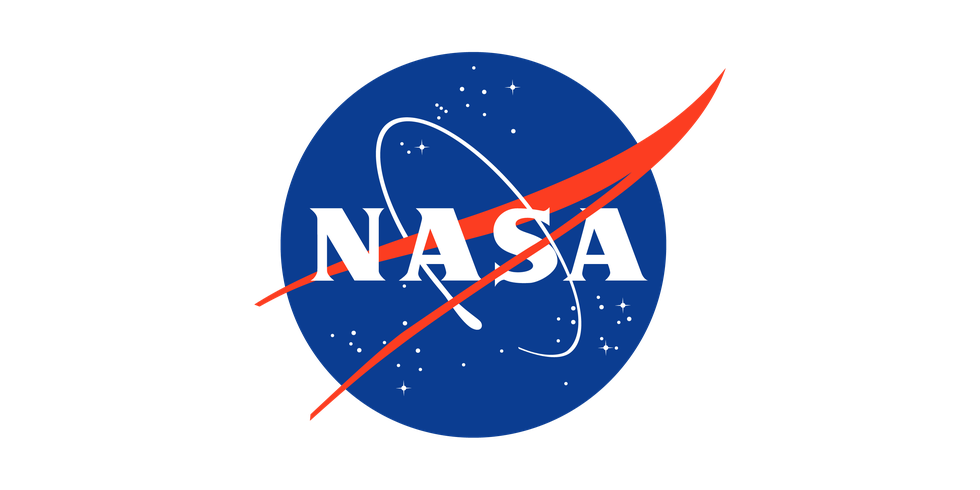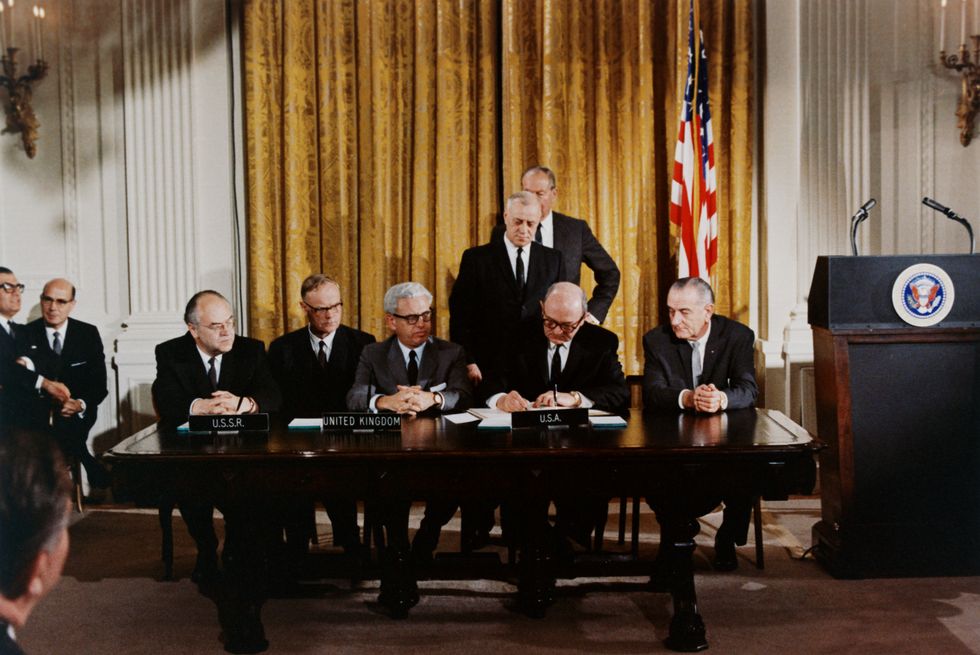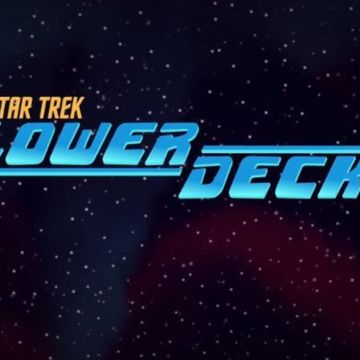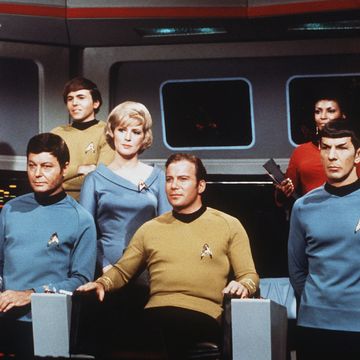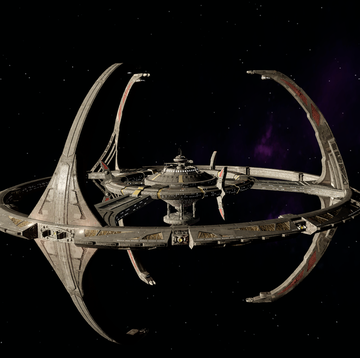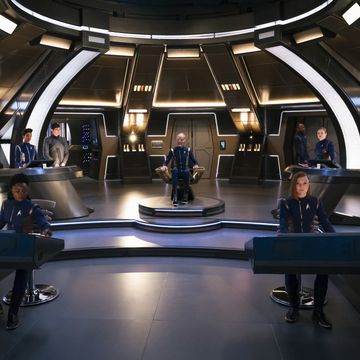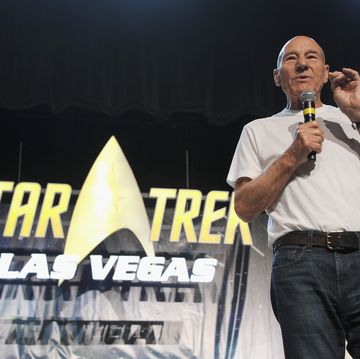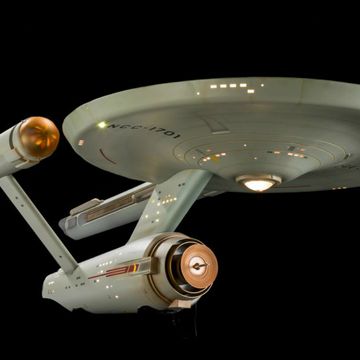If imitation is the sincerest form of flattery, Gene Roddenberry is blushing a deep red.
This past Friday, President Donald Trump revealed the logo for the newly minted sixth branch of the military—the U.S. Space Force. It struck more than a few people as familiar:
Yes, the Space Force logo and Star Trek's famous Starfleet logo are very similar. The Space Force also cribbed a design element from NASA's meatball logo by reversing the path of the white orbiting satellite:
But it's the insignia—the triangle-y looking thing—that's drawing so much attention. While it might seem like blatant infringement, the two insignias were actually inspired by two different sources.
According to The Washington Post, the Space Force cribs from past Air Force designs, while Star Trek's official website says its insignia is an in-universe evolution from the original NASA flight pin, first given to astronaut Deke Slayton in 1967. While Star Trek might have played a role in the insignia design (who knows, maybe the designer is a Trekkie), it isn't without its own Air Force origins.
But this isn't the first time that Space Force has copied Star Trek's homework—hell, it isn't even the first time this month. A few weeks ago, the Air Force announced it would be transitioning one of its units to the Space Force, designated the Space Operations Center, or SPOC—you see where this is going.
What's next: a saucer section and warp-capable nacelles on the X-37B, like the ones that adorn the Starship Enterprise? Will NASA's planetary protection policy become a guideline for Space Force's own Prime Directive, protecting fledgling galactic civilizations from alien influence? Will the Space Force eventually realize you don't need camo in space and opt for something a bit more colorful, like Star Trek's love of primary colors?
But all of these things are just aesthetic or technological tributes. Maybe this is the more important question: Will the U.S. Space Force also imitate some of the values of Starfleet? Let's hope so.
For Good or Evil?
While the Space Force feels like a grand venture, space law—the rules governing the airspace above nations (and beyond)—has been around for just over a century, eventually culminating in 1967's Outer Space Treaty. This treaty, signed during the Cold War, codifies the basics of international space law including a nuclear weapons ban, peaceful use of celestial bodies (i.e. no wars on the moon), forbidding nations from claiming any part of outer space as its own, and many other things.
But the treaty came with one big caveat: There was no outright ban of military operations in between celestial bodies or for defense, and it's within this legal gray area where the Space Force, and other rival ambitions, take root. It doesn't take much far future speculation to see how nations protecting certain claims in space, whether military assets or communication satellites, could suddenly flare into an all-out space war.
But this moral argument—should space remain peaceful?—also plays out in Star Trek itself, sometimes subtly within the United Federation of Planets, but also more overtly by comparing the Federation to its mirror universe counterpart—the Terran Empire.
In Star Trek (for the most part), the Federation is a peace-loving outfit comprised of many species (Humans, Vulcans, and Andorians being among its founding members) spread out in a vast expanse of the galaxy. Captain Jean-Luc Picard (who this month made a long awaited return to television) once said that "if there is one ideal that the Federation holds most dear, it is that all men...all races can be united."
This idealism is what drew so many people to Star Trek when it originally aired in the 1960s—an era that very much didn't reflect those values. Sure, sometimes the Federation resorts to war when all else has failed, and there are many episodes detailing just how dramatically the Federation fails to live up to its own ideals. But in the end, Star Trek believed that the struggle was worth it.
The Terran Empire represents everything the Federation abhors. Instead, Terrans, aka humans, are a plague upon galaxy, inciting war on any species it meets. This point is well illustrated in the opening scene of the Star Trek: Enterprise episode "In a Mirror, Darkly" where humans make first contact with Vulcans—and also draw first blood. The show's opening theme then supplants the Enterprise's hopeful imagery with scenes from humanity's darkest periods of war, all accompanied with a musical backdrop that sounds like a sinister military dirge.
Both space forces reached the stars and faced a similar fork in the space road: Should the final frontier be a place where humans embrace its better angels or devolve into a reflection of its inner demons? The Federation chose the path of peace. The Terran Empire did not.
These two options are a stark binary, and the truth most likely exists somewhere in between. But if the Space Force wants to take a few pointers from Starfleet, it should—and it should copy some of Starfleet's ideals as well.
Darren lives in Portland, has a cat, and writes/edits about sci-fi and how our world works. You can find his previous stuff at Gizmodo and Paste if you look hard enough.
